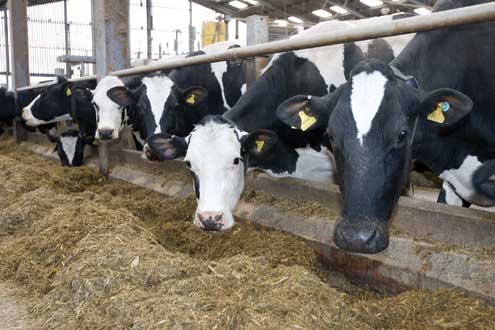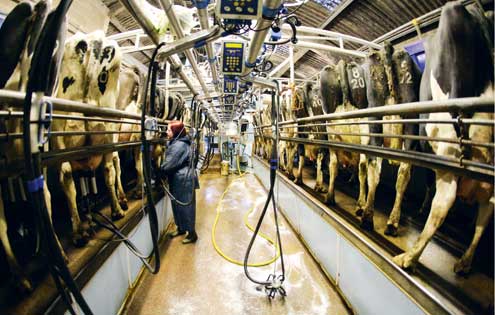Acidosis risk means balancing act for rations

An unpredictable season has left producers across the country with very wet or dry grass silages, with quality often hugely variable between cuts from the same farm.
Similarly, many will be faced with wet, acidic, low-starch maize crops and consequently diets will be screaming out for starch and energy, which will create a big challenge, said independent nutritionist Charlie King.
“Such variation in silage quality will mean most livestock farmers will have to deal with heightened risk of acidosis, low forage intakes and clamp heating,” said Mr King.
“There’s the potential for cows to develop acidosis just from acidic forage, even before adding concentrates, so careful planning is crucial.”
However, several steps could be taken to mitigate issues, said Adam Clay, ruminant manager at Frank Wright. “Both very wet and dry silages can cause acidosis, however the way in which you deal with the problem will vary depending on the silage you have,” he explained.
Wet grass silages
The problem
- Just under 20% of farms have silage of less than 20% dry matter (DM) this year (see table below)
- Silage under 23% DM viewed as “wet”
- Wet silages have high acid loading
- An average lactic acid level of 97.1g/kg in the 20% of wettest silages – could pose risk to rumen health
- Potential acid loading of 900meq/kg in the 20% wettest silages – this is the stage at which it can become an issue
- Intake characteristics poor – focus on rumen health so rations can continue to be broken down
- Poor structure won’t create a good rumen matt
- Metabolisable protein from nitrogen (MPN) higher in wetter silages – for every 400g of nitrogen it takes 5KJ of energy to break it down, so high MPN will take energy away from milk production
- High N levels could detrimentally affect fertility – rumen-available energy is needed to help break it down
Potential solutions
Wet silage would never produce the perfect diet, but producers should work with what they’ve got to deliver the right physical ration and nutrient balance.
1. Reduce or change starch levels
Mr King said he would advise those farmers facing an acidosis challenge to reduce the level of starch fed or change the type of starch to more rumen-friendly feeds.
“A maize-based starch, rather than a cereal-based one is more rumen-friendly so I’ll be formulating diets to include less cereals and more maize meal. Caustic wheat is also an option, as the alkaline nature of the caustic soda will help rumen pH.
“Feeding high-digestible fibre products like sugar beet will also help rumen health,” he said.
Mr King said reducing concentrate levels may also be appropriate in some situations. “Reducing the level of concentrate may seem wrong on paper, as you are “under-feeding”, but when you are experiencing acidosis, the cow is not using the diet effectively,” he explained.
“If, for example, you take 1kg of concentrate away, the rumen acid loading is reduced and the cow will eat more forage. This means the rumen is working better and milk production will be the same, if not more.”
At the same time, milk from forage would go up, resulting in a more cost-effective ration.
2. Rumen-protected fats
Mr King also believed rumen-protected fats such as calcium soaps were a good way of providing energy without creating additional acid loading. “It is not recommended to feed wheat with wet, acidic silage, so by feeding protected energy you are providing energy in a rumen-friendly form.”
| Water addition to diet based on silage DM% | ||
|---|---|---|
| Silage DM (%) | Water addition (kg/t TMR) | Total diet DM (%) |
| 28 | 0 | 44.9 |
| 30 | 0 | 47.2 |
| 32.5 | 0 | 49.9 |
| 35 | 47 | 50.1 |
| 37.5 | 98 | 50 |
| 40 | 128 | 50.7 |
| 45 | 221 | 50.5 |
| 50 | 294 | 50.7 |
| 55 | 373 | 50.5 |
| Source: Frank Wright | ||
3. Mix wet and dry silages
Having a dry silage alongside a wet one could be a lifesaver this year, said Mr Clay.
“Try as hard as possible to mix these silages to limit acid introduction into the rumen and also provide fibre to allow the rumen to stabilise.”
Depending on the quality of silage, feeding dry silage with wet may make feeding a buffer unnecessary, but check ration formulation and PAL.
Feeding dry forages, such as chopped straw or hay (to a maximum of two inches) could also help dry the ration out and create a more stable rumen.
4. Buffers and yeasts
Buffers could come into play to neutralise rumen acids, said Mr Clay. And although the low milk price may mean many producers are thinking of cutting “extras” such as yeasts and buffers out of the ration, Mr King said the level of acidic silages meant this may not be the year to be doing it.
Dry grass silages
The problem
- Driest 20% of grass silage crops average 44.7% DM
- Dryer crops may be rumen-friendly, but high lignin levels can reduce digestibility
- Higher lignin levels increase need for concentrate, raising acidosis risk
- Dry silages won’t bind to any blend or straight, increasing risk of cows sorting through mix
- Producers with wet silage to balance with dry won’t have to worry about sorting as much
- Driest 20% of samples had a pH of 4.4 – this will encourage secondary fermentation at the clamp face or in the trough resulting in reduced DMI
- It is still possible to have silages of 30% DM with a high acid loading – check by getting silage analysed
| Sheep farmers must assess silage quality |
|---|
| According to Tom Hough of NWF Agriculture there is a relationship between acidosis and twin lamb disease in sheep, so understanding forage quality is crucial this season. “Anything that hits energy intakes in the last six weeks before lambing will add to the pregnancy toxaemia risk.” And reduced dry matter intake in poor sheep could lead to abortion or even death. “When lambing twins, a ewe is like a high-yielding dairy cow. It’s crucial you understand silage quality to ensure she gets what she needs.” When forages were dry, Mr Hough advised adding molasses or anything that would stimulate intakes. |
Potential solutions
1. Chop dry silages
Chopping dry silage to 20-25mm will be essential to reduce the incidence of sorting and therefore increase the uniformity of the mix, said Mr Clay.
“If silage was not ensiled at the right length, use the feeder wagon to chop it to this level if possible, or use molasses to bind the mix and reduce sorting.
“There is a general misconception that long fibre is good for rumen health, but a shorter length can actually improve forage DMI, resulting in a healthier rumen,” said Mr Clay.
To reduce sorting, it’s also advisable to push up the ration at least six times a day.
2. Clamp management and organic acids
Move over the clamp face as quickly as possible and keep the face as tight as possible to limit clamp heating, advised Mr Clay.
“Organic acids can also be added to the mix if you find heating at the face. These act to neutralise the development of yeasts and moulds, but do not eliminate the problem.”
3. Improve palatability
Adding molasses or moist feeds to the ration can improve palatability and help achieve a target total ration dry matter of 45-55%, said Tom Hough of NWF Agriculture.
“In a TMR mix, the addition of water is also a cheaper version of molasses and can help dampen the mix down and improve intakes,” he said. (see table above for water addition needs).
| Grass silage averages 2012 | ||||
|---|---|---|---|---|
| First cut | Second cut | Wettest 20% | Driest 20% | |
| Dry matter (%) | 30.8 | 31.6 | 20.1 | 44.7 |
| Crude protein (%) | 13.6 | 12.8 | 13.4 | 13.3 |
| D value (%) | 67.5 | 64.2 | 65.6 | 67.7 |
| ME (MJ/kg) | 10.8 | 10.3 | 10.5 | 10.8 |
| pH | 4.1 | 4.1 | 4 | 4.4 |
| Sugar (%) | 2.6 | 2.6 | 2.1 | 3.2 |
| NDF (%) | 46.6 | 48.8 | 49.9 | 45.6 |
| ADF (%) | 32.1 | 33.7 | 33.8 | 32.5 |
| AD Lignin (g/kg) | 49.4 | 52.6 | 43.4 | 51.5 |
| VFA (g/kg) | 24 | 24.5 | 33.4 | 15.7 |
| Lactic acid (g/kg) | 67.8 | 59.1 | 97.1 | 39.6 |
| Intake potential (g/kg) | 101.5 | 96.2 | 88 | 112.6 |
| PAL (meq/kg) | 724.9 | 752.3 | 900 | 691 |
| MPN (g/kg) | 92.5 | 87.1 | 91.8 | 87.7 |
| Silage intake (kg DM) | 10 | 9.5 | 8.7 | 11.1 |
| Frank Wright – 5,000 samples across UK | ||||
Barry Coombes
NEW GROVE FARM, BLACKFORD, SOMERSET
As with most dairy producers this season, ration formulation has been a balancing act between milk yields and rumen health for Somerset producer Barry Coombes.
Having been faced with the wettest silage he’s seen in nine years, he took immediate action to prevent the development of acidosis problems in his herd of 180 11,000-litre Holsteins and 10 Ayrshires.
“Hay has been a lifesaver this year,” he said. “We were lucky in May, as we were able to make 30t of big-bale hay and then we have had a further 30t of small bales.”
Big bales are fed ad lib to the low yielders and smaller bales are put along the feed barrier for the high yielders. The aim is to provide the highs with 1kg a head a day, but Mr Coombes explained how it has come at a cost.
“1kg of hay replaces 5kg of silage dry matter intake, so yields are down about two to three litres a cow. But you do need to get forage into them, so we will have to sacrifice a bit of yield to maintain rumen health.”
Nine hectares of wheat has also been made into wholecrop silage for the first time to make up for a predicted 60% shortfall in maize crop yields.”The wholecrop is 50% dry matter, so will also help make the ration drier,” Mr Coombes explained.
The fact the ration includes a proportion of fodder beet also adds to the wetness of the mix, making the addition of fibre more important.
Mr Coombes’ nutritionist, Charlie King, explained how the farm’s wet first-cut silage has been mixed with dry second-cut to minimise acid loading.
“First-cut silage was very wet at 20% DM with 130g/kg lactic acid, but second-cut is drier with less lactic acid (39g/kg). We’re planning to feed the two silages together to minimise acid loading from this element of the ration.”
The dairy blend fed in the TMR also contains no cereal to minimise starch and acid load. It has a high level of sugar beet pulp and is only 7% starch overall. “We also feed a protected fat to add energy without having to feed more starch and/or concentrate.
“And the dairy cake is sugar beet based (high digestible fibre) and contains protected fat to provide extra energy without adding extra starch and acid load to the highest yielding cows,” said Mr King.

